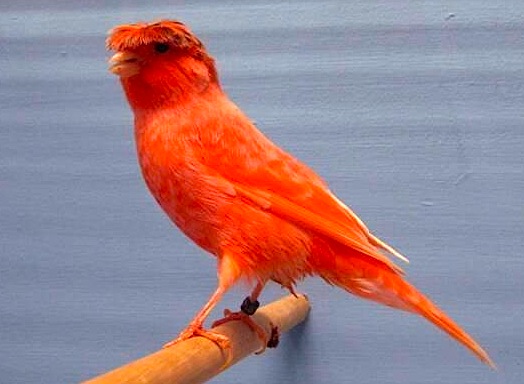For millennia, cayenne in its various forms has been considered to be beneficial to mankind both as a food and a medicine. Researching in Google Books, I came across the following uses for cayenne, which has become a generic term for any hot red chile powder.
The Cayenned Canaries
 At any ordinary bird show, canaries of a special breed the chief point and excellence of which is, I believe, the altogether unnatural red, or rather orange colour, are shown. Mr. Tylor has been good enough to procure for me, from a friend of his who is a noted breeder of these canaries, the following particulars of the process employed : “Commence,” he writes, “the process three weeks “before the bird is likely to begin changing his plumage, in order that he may become thoroughly accustomed to “the food, and his system may be well saturated with it. At first mix in equal proportions cayenne, sweet biscuit-powder, and hard-boiled yolk of egg. The egg must be grated as fine as the other ingredients, or the bird will pick it out and leave the cayenne. Take away all the other food until the bird eats the cayenne readily, and only give a very few seeds until he begins to moult, when the red food should be given only, and the proportion of cayenne raised to quite one-half. Take care not to revert to ordinary food until the new feathers are thoroughly grown. The small head-feathers will not be quite opened till three weeks after the last “feather drops, though the period varies in length, and probably would be more rapid in the tropics. I should say that it takes about 6 ounces of cayenne pepper to moult a canary. The cayenne pepper sold by grocers is never bright enough in colour. The pepper used for birds is called Natal pepper.” Mr. Tylor adds that his friend has recently tried a special preparation, called “canaryper,” which is cayenne with the heat extracted from it, and has found it as efficacious as the hot pepper.
At any ordinary bird show, canaries of a special breed the chief point and excellence of which is, I believe, the altogether unnatural red, or rather orange colour, are shown. Mr. Tylor has been good enough to procure for me, from a friend of his who is a noted breeder of these canaries, the following particulars of the process employed : “Commence,” he writes, “the process three weeks “before the bird is likely to begin changing his plumage, in order that he may become thoroughly accustomed to “the food, and his system may be well saturated with it. At first mix in equal proportions cayenne, sweet biscuit-powder, and hard-boiled yolk of egg. The egg must be grated as fine as the other ingredients, or the bird will pick it out and leave the cayenne. Take away all the other food until the bird eats the cayenne readily, and only give a very few seeds until he begins to moult, when the red food should be given only, and the proportion of cayenne raised to quite one-half. Take care not to revert to ordinary food until the new feathers are thoroughly grown. The small head-feathers will not be quite opened till three weeks after the last “feather drops, though the period varies in length, and probably would be more rapid in the tropics. I should say that it takes about 6 ounces of cayenne pepper to moult a canary. The cayenne pepper sold by grocers is never bright enough in colour. The pepper used for birds is called Natal pepper.” Mr. Tylor adds that his friend has recently tried a special preparation, called “canaryper,” which is cayenne with the heat extracted from it, and has found it as efficacious as the hot pepper.
From: Timehri: Being the Journal of the Royal Agricultural and Commercial Society of British Guiana, Volume 3, by The Royal Agricultural and Commercial Society of British Guiana. Demerara, Guyana: J. Thomson, 1884.





